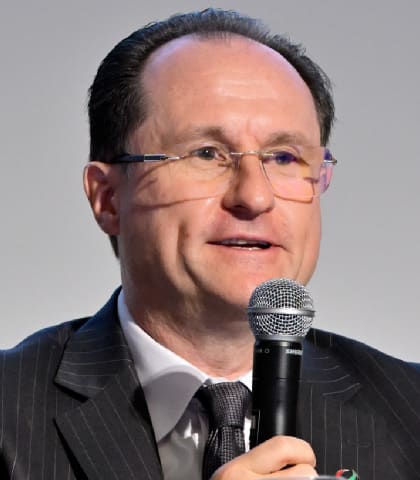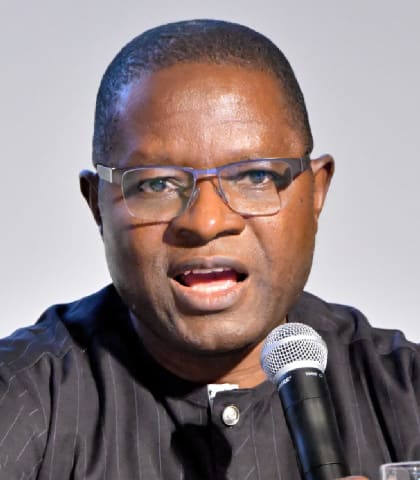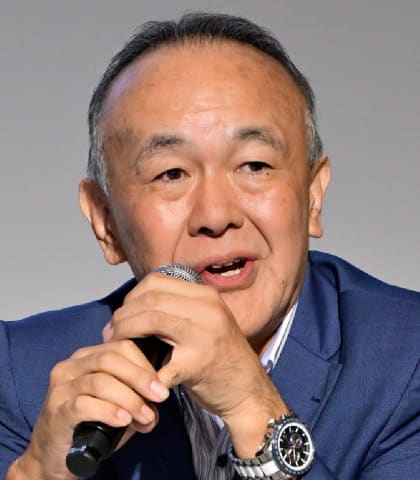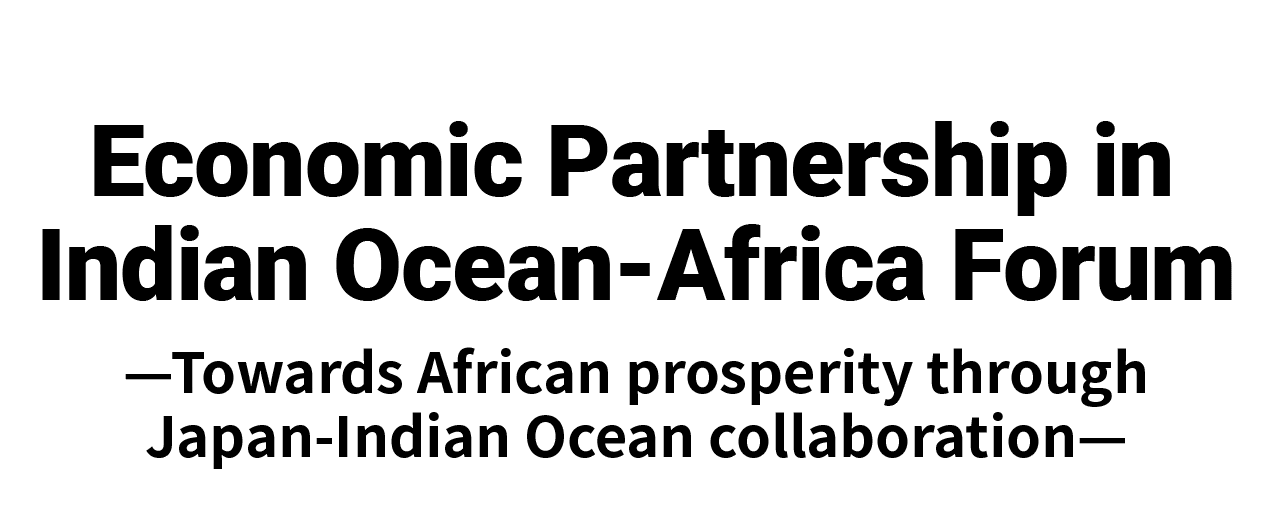Collaboration with Third-Country Companies in Expanding into Africa
<Keynote Speech>
Naoki Ando, Senior Vice President, Japan International Cooperation Agency (JICA)
<Panelists>
Ichiro Inagaki, Chief Representative of Middle East and Africa Bloc, Mitsui & Co., Middle East
Beat Simon, Group Chief Operating Officer, Logistics, DP World
Victoria Backhaus-Jerling, CEO, African Association of Automotive Manufacturers (AAAM)
Kevin Chika Urama, Chief Economist/Vice President, African Development Bank Group (AfDB)
Susumu Tsubaki, Founder & CEO, Asia Africa Investment and Consulting (AAIC)
<Moderator>
Sonoko Watanabe, Senior Consulting Executive Officer, Nikkei Inc.

Naoki Ando

Ichiro Inagaki

Beat Simon

Victoria Backhaus-Jerling

Kevin Chika Urama

Susumu Tsubaki
Finding Reliable Partners to Manage Risks
In his keynote speech, JICA Senior Vice President Naoki Ando stated, “While the opportunities for Japanese companies to venture into Africa are growing, total Japanese investment in Africa remains low, at just US$8 billion. The barriers include regulatory uncertainty, lack of infrastructure, and political and security risks.” He stressed the importance of partnering with local and third-country companies to help manage risks. Asserting JICA’s readiness to cooperate, he said, “JICA possesses substantial know-how, cultivated from human resource networks through technical cooperation, and from investment and financing, and infrastructure support projects. We encourage companies looking to do business in Africa to take advantage of assets of our development cooperation”
In the panel session, the panelists discussed the current situation and challenges associated with working with third countries in Africa.
—How are you utilizing the cooperation of third countries in your business development in Africa?
Tsubaki: Here are two examples. One is the large-scale oil refinery built in Nigeria in 2024 by the powerful Dangote Group. This state-of-the-art refinery, with a processing capacity of 700,000 barrels per day, utilizes Indian technology. Furthermore, approximately half of the engineers working there are Indian. The refinery was built and has been operated primarily by Indians and Indian companies. The second example is the collaboration between Sharp and the major Egyptian consumer electronics manufacturer Elaraby in Egypt. Sharp handles development, design, quality control, and branding, while Elaraby takes care of the manufacturing and sales. This model has proved successful.
Inagaki: ETG, a company Mitsui & Co.,Ltd invested in, operates primarily in Africa and the Indian Ocean region. It engages in agricultural product trading and sale of farm supplies. It is steadily expanding its business focused on the goal of supporting the independence and growth of farmers. Across Africa, the company operates nearly 500 “farm gates.” It uses these facilities to purchase grains from farmers and sell them fertilizers and other supplies. An essential factor behind the development of this network is that the family that founded ETG is of Indian origin. This fact has enabled them to leverage connections within Indian communities around Africa. After more than 50 years of active business operation, ETG is now a fully African company.
—How can third-country companies support businesses that face difficulty trying to establish themselves in Africa?
Simon: To do business in Africa, you need a trustworthy partner. DP World is a state-owned enterprise headquartered in Dubai in the United Arab Emirates. It operates port and logistics services worldwide, using its own platform for global trade. In Africa, it provides not only port services but also logistics services for connecting inland regions. We can help client companies that struggle to operate effectively in Africa by working with them as a distribution partner. By facilitating access to markets, we create an environment that allows them to compete with other local players.
――Many members of the African Association of Automotive Manufacturers (AAAM) are overseas automobile-related companies such as finished vehicle and parts manufacturers. What kind of role does the association play?
Backhaus-Jerling: Africa's new car market currently stands at 1.2 million units annually, with production volumes at a similar scale. Our goal is to grow the market to over 5 million new vehicles; by 2035, we aim for an annual market size of 3.5 to 5 million units. As production increases, export opportunities will also expand. Of course, there are challenges. Within the association, we have established 11 subcommittees focused on areas like asset-based vehicle financing and skill development. We aim to develop the regional automotive value chain. We are collaborating with the African Continental Free Trade Area (AfCFTA) Secretariat and also providing advice and support to the governments of various African countries. Our members also include local companies, and we work together with automotive organizations of African countries.
――What is the current state of the African economy?
Urama: Africa is one of the fastest-growing regions in the world, thanks to macroeconomic and governance reforms, and improvements in the business environment. In my 35 years of professional involvement in economic development, I have never felt so optimistic about Africa’s growth potential as I do now. The African economy has been growing at an average annual rate of 4% for 20 years straight. Over 20 countries on the continent have sustained annual growth of over 5%. In 2022, five African nations were ranked in the top 20 fastest-growing economies in the world. By the end of this year, there are likely to be 13, which will be more than half the total. Following the announcement of U.S. tariff hikes, in May we revised our 2025 growth forecast downward, but only to 0.2 percentage points below our February projection. Taking into consideration macroeconomic indicators, along with demographic trends, the growing middle class, and the economic potential of mineral resources essential for manufacturing automobiles and other goods, the African economy remains fundamentally positive and resilient.
Inagaki: Along with the many opportunities, there are also challenges. As an example, many farmers in Africa do not have bank accounts, so they are unable to purchase expensive agricultural machinery on installment plans. To address this, ETG has partnered with a mobile money company to launch a system that tracks the payment histories of farmers to determine whether the company can offer sales on installment plans in communities with only a certain level of creditworthiness. We are also increasing the number of processing plants to help create jobs, which is a challenge in Africa.
Simon: It can undoubtedly be challenging to start doing business in Africa. While Japanese companies value consensus, relationship-building in Africa can be quite wild. While Japanese companies excel at long-term planning, rules and regulations in Africa can change frequently. This is why it is so essential to find partners with deep local knowledge.
Urama: Investing in solutions to eliminate bottlenecks in Africa leads to win-win outcomes. For productive business development, the most important thing is investment in infrastructure and logistics, followed by investment in energy and IT systems. The energy gap also needs to be closed. Africa is also a frontier for innovation in sectors such as fintech. Competition in the minerals sector is also fierce. Japan possesses “trust capital”. Its reputation for delivering high-quality infrastructure, maintaining a long-term perspective, and seeing projects through to completion is well-established. The pace is slow, however. We must do something about this.
Backhaus-Jerling: For auto industry, Africa is the last frontier. Companies that have grown by entering India are now looking to expand into Africa to avoid falling behind their competitors. To build the regional automotive value chain, it is important for many countries to participate and play a role. The production of finished vehicles is currently centered in South Africa, Morocco, and Egypt, while assembly has begun in Ghana and other countries. Manufacturers of electric vehicle batteries have entered Morocco. Mineral beneficiation is increasingly significant. Although copper rods used for wire harnesses are not yet produced in Africa, it is conceivable, for example, to mine copper in Zambia, process it into copper rods in Botswana, and manufacture copper wire in South Africa. Naturally, there are challenges as well. Competition from the abundance of used cars in Africa is a significant hurdle. There must be demand for new cars, which depends on government policies and the affordability of new vehicles.



